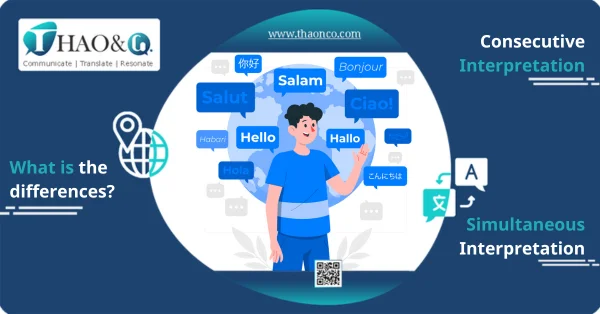What should you keep in mind regarding Consecutive and Simultaneous Interpreting? Today’s globalized world has resulted in a heightened level of cooperation and partnership between countries speaking different languages. However, the success of these multilingual negotiations often hinges on mutual understanding.
To address this predicament, interpreting became widely employed to remove language barriers and improve communication efficacy, especially in global conferences.
It can be said that interpreters serve as linguistic bridges to ensure that information is delivered to relevant parties. “Interpreting” is an umbrella term that is further subdivided into specific categories. In this article, Thao & Co. will disclose the main differences between the 2 most common interpreting methods: consecutive and simultaneous interpreting.
Consecutive and simultaneous interpreting both involve interpreters relaying the messages from the original language to the target language. However, these 2 interpreting methods markedly differ in how information is interpreted. This article will present 5 criteria to differentiate between consecutive and simultaneous interpreting, helping you choose the right service for your needs.
With Simultaneous Interpreting, or Cabin Interpreting in Vietnamese, information will be interpreted concurrently with the speaker. The interpreter will be stationed inside a soundproof booth and listen to the speaker via headphones then relay translated information through a microphone.
In the meeting room, listeners can receive the interpretation via headphones. The interpretation process must happen quickly to avoid hindrances in communication.
On the other hand, Consecutive Interpreting is done after the speaker has finished one or a few meaningful sentences. Interpreters often take notes when interpreting to avoid missing important information.
After the speaker has made a few complete sentences, the interpreter renders the message to the target language; the speaker then continues with their speech, and the cycle repeats until the conversation ends.

Simultaneous interpreting aims to render information from the source to the target language almost concurrently with the speaker. This interpretation technique is most suitable for multilingual conferences. In long discussions, simultaneous interpreting helps participating parties communicate in an efficient and speedy manner.
With consecutive interpreting, interpreters will be allowed a larger margin of time to interpret. This also leads to a higher standard in terms of not only accuracy but also intonation and expressive quality of the interpretation. In some circumstances, such as a presentation, consecutive interpreters must pay special attention to non-verbal cues as well as the overall emotion of the speaker and faithfully convey this when interpreting.
Based on the procedures and objectives of these two interpretation methods, you can opt for the service that most aligns with your needs.
The consecutive interpreting process often continues even after the speaker has finished their speech. This is because consecutive interpreters must wait until a few sentences have been said before beginning to interpret, leading to a delay of a few seconds. Therefore, this interpreting method is most suitable for small-scale meetings and 1-1 discussions such as:
Meanwhile, simultaneous interpreting works well in large-scale events with a large number of participants:
Simultaneous interpreters must satisfy the following criteria:
Requirements for consecutive interpreters:
The interpreting fee is charged based on working hours, sessions, days, and the complexity of the project, in addition to the specific expertise and effort required of the interpreters.
Furthermore, the interpreting fee is also subject to changes depending on the content complexity, language rarity, and the event scale, among others.
Generally speaking, the inherent complexity involved in simultaneous interpreting often results in a more premium price than consecutive interpreting. Several constraints that elevate the difficulty level of simultaneous interpreting include limited time and higher demands on adaptability. Furthermore, interpreters often have little time to prepare due to the confidential nature of seminars.
All in all, it can be seen that simultaneous interpreting places a much heavier strain on interpreters than consecutive interpreting. Because of the heavy workload, simultaneous interpreters are often subbed out every 15-20 minutes to maintain interpreting quality. The added requirements in terms of resources and supporting devices in simultaneous interpreting also result in a higher cost.
Each of the two interpretation approaches comes with distinguishing features, posing different requirements and challenges to interpreters. Both aspiring interpreters and customers can refer to the following notes to gain a better understanding of both interpreting methods.

Seminars that require simultaneous interpreting are those that last from 2 hours to several days. In these multi-hour / multi-day events, interpreters run the risk of burning out from long spans of heavy concentration or suffering from dry throat, thereby leading to an overall deterioration of interpreting quality
Furthermore, being required to interpret concurrently with the speaker means simultaneous interpreters will have very limited time to delve on words and come up with accurate equivalences, let alone catchy ones. This is an added challenge, especially when difficult industry-specific terminologies are concerned.
On the contrary, consecutive interpreters are allowed a more generous timeframe to operate, resulting in a higher expectation of interpreting quality. It is important to note that interpreting word-by-word may lead to confusion due to reasons such as lengthy, repetitive, wordy, or unnecessarily complicated sentences on the speaker’s part. Instead, interpreters are required to possess extensive knowledge of related fields to flexibly deliver information to listeners in a concise and comprehensible manner.
Occasionally, the speaker’s sentences may carry hidden meanings or contain witty remarks that are potentially controversial. In these cases, interpreters must deftly filter out the core information and appropriately relay it in the target language to avoid coming across as offensive in the listener’s culture.
It is recommended that you conduct thorough research on the translation agency along with the interpreting services being offered to avoid unexpected expenses and problems.
Understanding the inherent difficulties of these 2 interpreting methods, Thao & Co. translation agency is proud to be a reliable partner to support you in overcoming language barriers.

We are dedicated to delivering high-quality interpretation services carried out by native experts possessing extensive experience and profound knowledge in various fields.
To help your business ride the wave of globalization with international cooperation, Thao & Co. centers our work around accuracy and context appropriateness for the best quality language services.
Still don’t know which interpreting method your business needs? Spending hours finding a professional translation agency to partner with? Leave your information on the Get a Quote page for detailed consultation from Thao & Co.’s expert team for no charge at all!